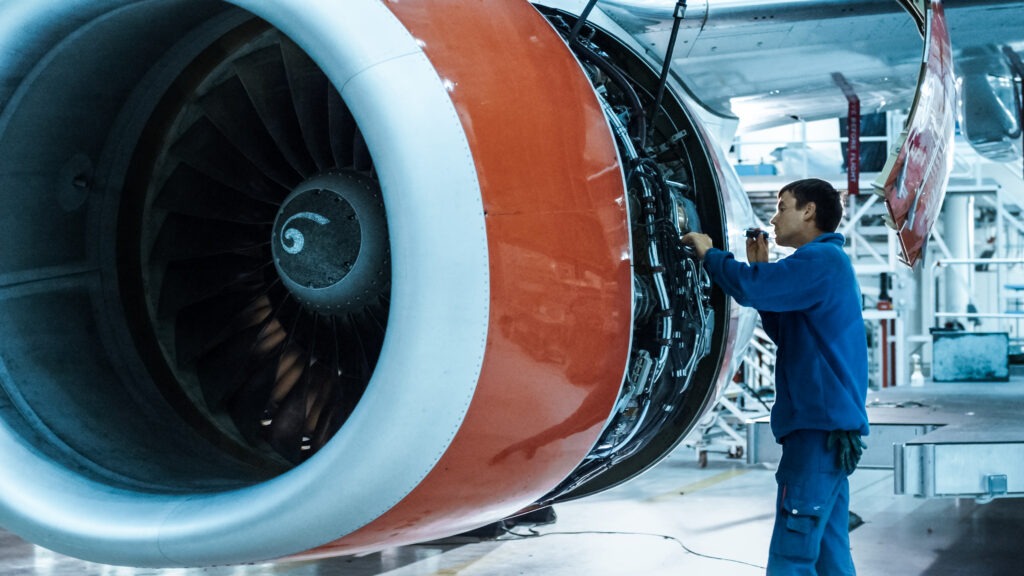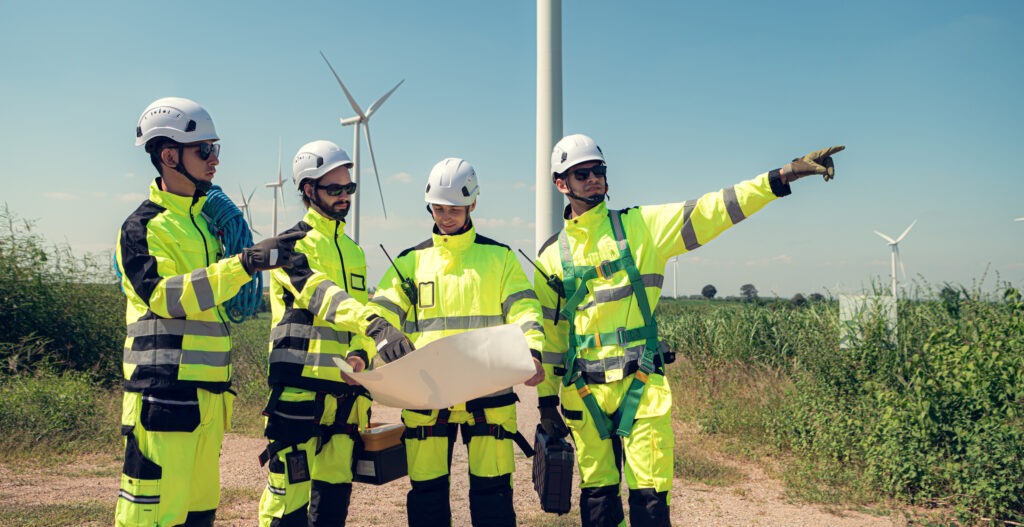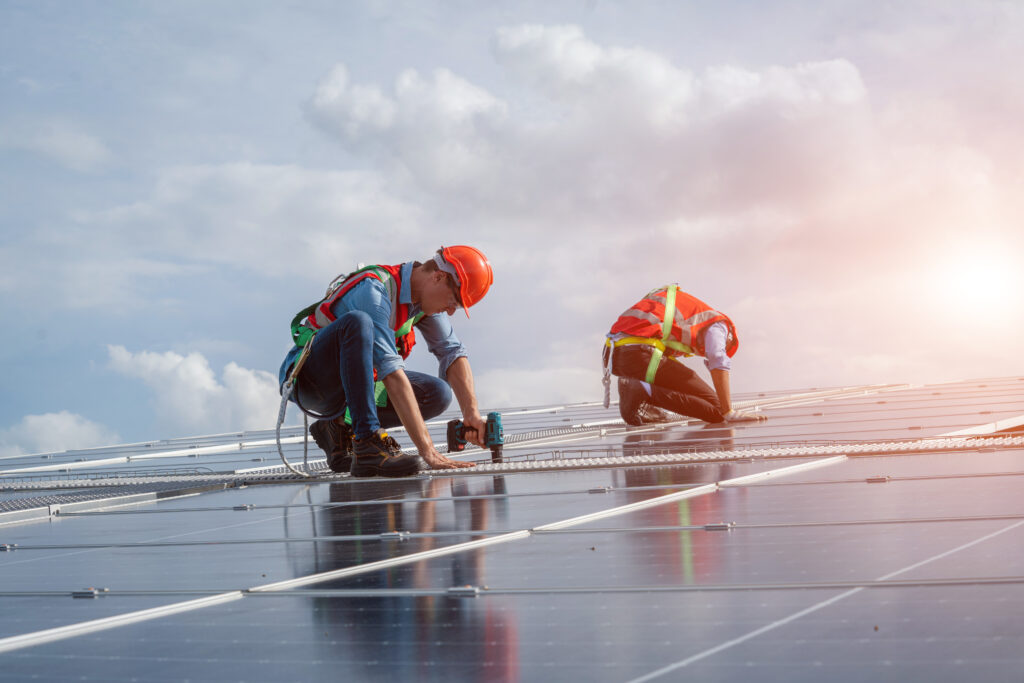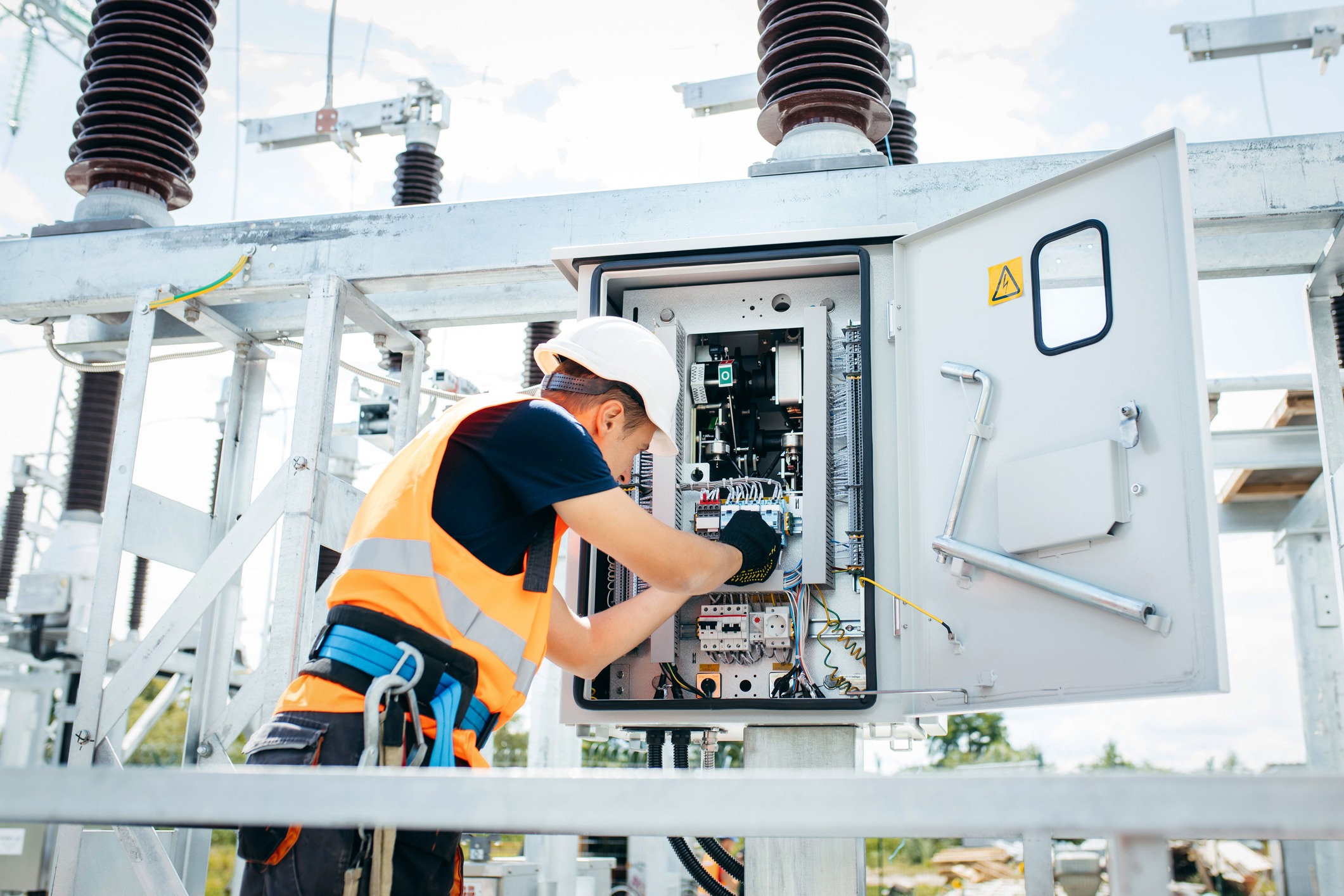Special areas of application for electricians
In addition to the everyday tasks of an electrician, there are also areas of work that involve something special. These are the extraordinary jobs that require more attention, are highly respected and often involve higher incomes.
Table of contents
Estimated reading time: 17 minutes
Aircraft electronics technician
However, an aircraft electronics technician does not do the work of an electrician in a home or on a production line. Instead, they install systems and equipment in helicopters and aeroplanes. This is not just about the smooth operation of the finished aircraft and compliance with typical safety regulations. The strict regulations that apply to aircraft must be adhered to.
The particularly strict safety requirements for aircraft are a result of their special characteristics. For example, if something goes wrong, aeroplanes or helicopters cannot simply pull over and stop like a car. Nor can the people on board simply leave the aircraft. In addition, with often several tonnes of fuel in the tank, their size and speed, they pose a considerable risk to people on the ground.
Special requirements for aircraft electronics technicians
Here diligence and a strong sense of responsibility are required. Cables for data transfer, signal transmission and control are installed in the aircraft. In addition, there are the systems for supplying power and the computer systems that house the flight management system.
During maintenance, it must be measured and analysed whether the entire control, measurement and regulation technology is working within the prescribed parameters. Due to flight safety, the systems are designed with multiple redundancies - this must be taken into account when analysing them.
Defective devices must be found before dangerous failures occur during operation. The devices themselves must be repaired or replaced. In case of doubt, a completely new installation must be carried out. The equipment must be commissioned and tested on board and while still on the ground.
The specifications must be strictly adhered to during the work and all work steps must be precisely documented. A further special authorisation is then required to approve the aircraft for operation.
An aircraft electronics technician must be familiar with the many kilometres of electrical wiring. They must understand the flight control systems and also be able to use the autopilot. Aircraft electronics technicians often carry out their work under considerable time pressure. This is always the case when the pilot detects and reports a fault before the aircraft is cleared for take-off.

What are the challenges of working at an aircraft manufacturer?
If you work for a manufacturer of aeroplanes or helicopters, on the other hand, there is less time pressure. However, you will have to work very carefully, lay cables correctly, connect them exactly as specified and check that all systems are functioning correctly. Always be aware that you are always responsible for the lives of many people. This is what makes working in this field so extraordinary, exciting and challenging.
Depending on the company and position, aircraft electronics technicians may have to work shifts and be available for work at weekends. They also have to work in assembly, outdoors and in the hangar or production hall.
High-voltage electrical technician or electrician
High-voltage current is more widespread than most people realise. This is partly due to the fact that cookers in the home are powered by this and the charging station at home is also connected to high voltage current. At first glance, this makes high-voltage current less special.
In reality, however, working on systems for medium and high voltages continues to be a real challenge. We are talking about voltage ranges of 30,000 volts and more. This quickly inspires respect, which shows that working in this area is something quite extraordinary.
The work on such systems consists of installing, maintaining, retrofitting and repairing components and measuring systems. This means that the systems have to be measured, cleaned if necessary, adjusted and checked for correct functioning.
In addition, customers must be supported and advised on site. This is particularly the case when the systems are connected on larger construction sites where many external companies work together.
What is high voltage current and its areas of application?
Heavy current, also known as high voltage, consists of voltages of more than 1,000 V for alternating current and more than 1,500 V for direct current. It is mainly used in production facilities, factories and power plants . It is also used to drive large electric motors and is used in transformers and various high-performance devices.
The voltage of the current makes it particularly dangerous. Therefore, only trained specialists may work on such systems or install and connect them.
High-voltage electricity is generated in power stations and transmitted via a high-voltage grid. This reduces losses that occur due to resistance in the lines. Typical users are producers of aluminium, steel and other metals. There are also trains and trams, as well as telecommunications companies for the operation of transmission systems.
High-voltage current makes it possible to work with higher performance. Only low line losses occur. This is in the nature of things. At higher voltages and lower currents, the losses are reduced. This increases the efficiency of energy transmission, which in turn leads to cost savings and protects the environment.
On the other hand, the potential risk increases. The installation costs are also higher and the application is only possible to a limited extent. High-voltage systems should not be operated in residential areas or near flammable materials.
Electrician in wind energy
Wind energy is another special area of application whose importance is constantly increasing with the demand for renewable energies. Where onshore wind turbines are already a challenge due to their size and height, offshore turbines are in a class of their own.

What are the challenges of working in wind farms?
The challenges for onshore installations include the weather, the heavy current that is generated and the altitude at which the actual work is carried out. However, all of this is multiplied for offshore installations. Here, the heights are even higher, the currents even stronger, the weather and especially the wind a very important factor and the accessibility or access to the installations even more difficult.
However, it is precisely because of these challenges that work in this area is associated with considerable prestige and, of course, better pay. This is why many future electricians want to work in this field.
If you dream of becoming one of these technicians and electricians, if you are driven by a special thirst for action, here is some good news first of all. Many companies are active in this field with thousands of jobs and, once again, skilled labour is desperately sought after. So if the adventure associated with this work appeals to you a little, then work on a wind turbine in the countryside. But if you are drawn to the full adventure, then offshore wind turbines are your field of activity.
There are thousands of offshore wind farm projects around the world and many more on land. Turbines have to be installed, maintained, repaired, upgraded, inspected and, if necessary, dismantled. All this happens for a reason. It offers the opportunity for sustainable energy generation and advances the energy transition.
What special qualifications do electricians in wind farms need?
To really emphasise the adventure, you will usually reach your place of work in the field of offshore installations by helicopter or on a ship. You must be trained as an electrician and qualified to work with high-voltage power lines. You should also have experience in the field of high voltage current. Your place of work can be anywhere in the world. Therefore, in addition to knowledge of German, a good understanding of English is also required. You must be able to work in a team and be prepared to travel. In addition to physical fitness, you must also be able to work at heights.
Employment in Germany usually involves 38.5 working hours per week and 30 days holiday per year. You will receive a company pension allowance, usually in the region of 20 %, and you can expect a lot of training in real-life conditions. So you'll be well equipped for your work and your life.
Teams in the offshore wind turbine sector are also characterised by a high degree of diversification. This means that you will find people of both genders, all nationalities and political views. This makes it easy to make friends and you will be working in a clearly international environment.
Life in an offshore wind farm
Working in offshore wind farms is not just a question of professional activity. It is also a question of life. The location is far from land. It therefore makes no sense to fly in or ship in the skilled workers every morning. That would take far too long and be far too costly. So life has to follow work here.
A 14/14 rhythm is typically planned for this - i.e. 14 days of work on the offshore installation, followed by 14 days off. This regular sequence gives the workers sufficient time to recover and helps them to recharge their batteries. It also makes it easy to plan the year.
During the 14-day work phase, you will of course also spend the night at sea in a floating home. This is done on a ship that is anchored near the plant. However, there are also exceptions to this rule. Depending on the exact location of the resort, the accommodation may also be close to the harbour. Either way, the accommodation is designed to meet the needs of offshore operations. This means that they offer employees everything they need to relax with their team members.
What are the requirements for becoming a wind energy electrician?
In order to meet the special requirements of working in offshore wind turbines, the specialists must have several certificates. These include:
- Training as an electrician
- GWO training: GWO stands for Global Wind Organisation. The training covers working at height, first aid, fire safety, manual labour and survival at sea
- The qualification for working on high-voltage systems
- A passed medical fitness test for work in the offshore sector
- Training in the use of personal protective equipment.
What is IRATA training and what is it needed for?
Then there is the IRATA training. Some installations require access practically suspended from a rope. This is what IRATA, the International Industrial Rope Access Trade Association, is for. This means that electricians and other skilled workers learn how to master rope access to their workplace.
With an IRATA licence, you can prove that you have passed your training as an industrial climber. This means that you can now use rope access technology to carry out your work inspecting, installing or repairing electrical systems. This gives you a lot of prestige and your pay is also significantly higher.
The IRATA training takes place in a separate course. The licence obtained is valid for 3 years. After that, the course must be completed again. There is no shortened refresher. Instead, you have to go through the complete training for the licence again every 3 years in order to obtain the highest level for your skills in this area.
The training lasts 5 days, which also includes the final examination. To take part in the course, you must prove that you are physically fit and suitable for working at heights. You must also be at least 18 years old and it is recommended that you have already completed the first aid training.
What levels are available for the IRATA licence?
There are 3 levels for the IRATA licence and each level is taught separately over 5 days. The levels are:
- Level 1: The completion of specified tasks under the supervision of a supervisor with an IRATA Level 3. To this end, rope access techniques and regulations as well as procedures for avoiding accidents are taught.
- Level 2: The ability to attach work ropes for industrial climbers, perform rescues and carry out work under the supervision of an IRATA Level 3 supervisor. To pass the 2nd level, 1,000 working hours with IRATA Level 1 must also be demonstrated. The course teaches how to avoid accidents, comply with international safety standards and work in mixed teams.
- Level 3: The ability to plan projects in management positions and actively lead them in action. Proof of 1,000 rope work hours from the area of level 2 must be provided. First aid training is also mandatory. Training is provided on how to avoid accidents, how to set up and monitor construction sites, which legal requirements must be observed and the graduate must be able to carry out complex rescue techniques.
Working on onshore wind turbines is already an adventure, but this is multiplied in the offshore sector. Special circumstances apply, such as living in the wind farms, travelling by ship or helicopter, working at great heights and much more. The real highlight of the work and the adventure is the rope access, for which special training must be completed.
Electricians on drilling ships and oil platforms
Working on drilling ships and oil platforms is in many ways similar to working in the offshore wind farm sector. For many years, it was considered the dream of particularly adventurous professionals and the reasons for this are manifold. In addition to the adventure itself, it is the organised environment, the good pay and the free accommodation and care during the assignment that make employment in this field so attractive.
When it comes to the work itself, it hardly differs from what an electrician does in everyday life. Systems are installed, maintained, repaired, upgraded, connected, set up and more. The difference, however, is that this is no longer done on land, but on a ship or an oil rig. This brings an adventure similar to that of offshore wind farms.

How much do you earn on an oil rig and what factors influence your salary?
In fact, jobs on oil rigs are among the best-paid professions of all. There are around 2,800 of them worldwide and labour is needed on every one. This also includes electricians and electricians. There are also drill ships, which also offer good pay.
However, the adventure and the good salary are also offset by work that demands a lot from the specialists. This applies both physically and mentally. Not everyone can keep up with the extremely hard work and not everyone can cope with the separation from country life and family.
A 14/14 rhythm also applies in the area of the oil rigs, i.e. 14 days on the island alternate with 14 days at home. There are also 30 days of paid holiday. Working hours of 12 hours per day apply for the 14 days at work. The salary for electricians starts at €4,500 per month. The company also covers the costs of travelling to and from work, including flight tickets.
What requirements do electricians on the oil rigs have to fulfil?
Good physical fitness is required for the work. Accommodation on the oil rigs and ships consists of a cabin for one person or a maximum of two people. Accommodation and catering are free of charge, but leisure activities are of course limited. There is no going to the pub around the corner, as you can easily imagine.
Now, of course, the question arises as to what future prospects a job on an oil rig has. Two things can be mentioned here. Firstly, working on an oil rig or drilling ship is not so different from working in offshore wind farms. If you are qualified for one, you will also be taken on in the other. This means that there is always the chance to change jobs if necessary.
It is also interesting to note that with rising oil prices, investment in the oil rig sector is also constantly increasing. This means that labour is desperately needed here too and demand will continue to rise in the near future.
Conclusion
There are a number of very special fields of work for electricians. This includes working as an aircraft electronics technician. Here you are responsible for many lives and millions in assets. You are required to work very carefully and strictly observe the many safety regulations. The work is often carried out in shifts with assignments at weekends and sometimes under time pressure.
Another special occupation is working as a high-voltage electrician. There is a particular risk here, which means that only specially trained specialists may be employed in this field. What makes this job so special is the demands of the job and its importance for the industry - because heavy current enables the operation of energy-intensive systems with high transmission efficiency.
Wind energy also presents special challenges. These include the high voltage current generated, the working height and the weather. All of this is multiplied when working in offshore wind farms. The real adventure is added here. Together with rope access work, this is not only a special job that requires a great deal of care and concentration, but also a well-paid occupation.
Working in offshore facilities is similar to working on drilling ships and drilling rigs. Here, too, the work involves a lot of adventure and good pay. As in the offshore wind farm, work is also carried out on a 14/14 basis, which is strenuous but also offers a lot of free time. Thanks to rising oil prices, investments continue to be made here too, meaning that a job in this sector continues to have a bright future.
Related topics:



